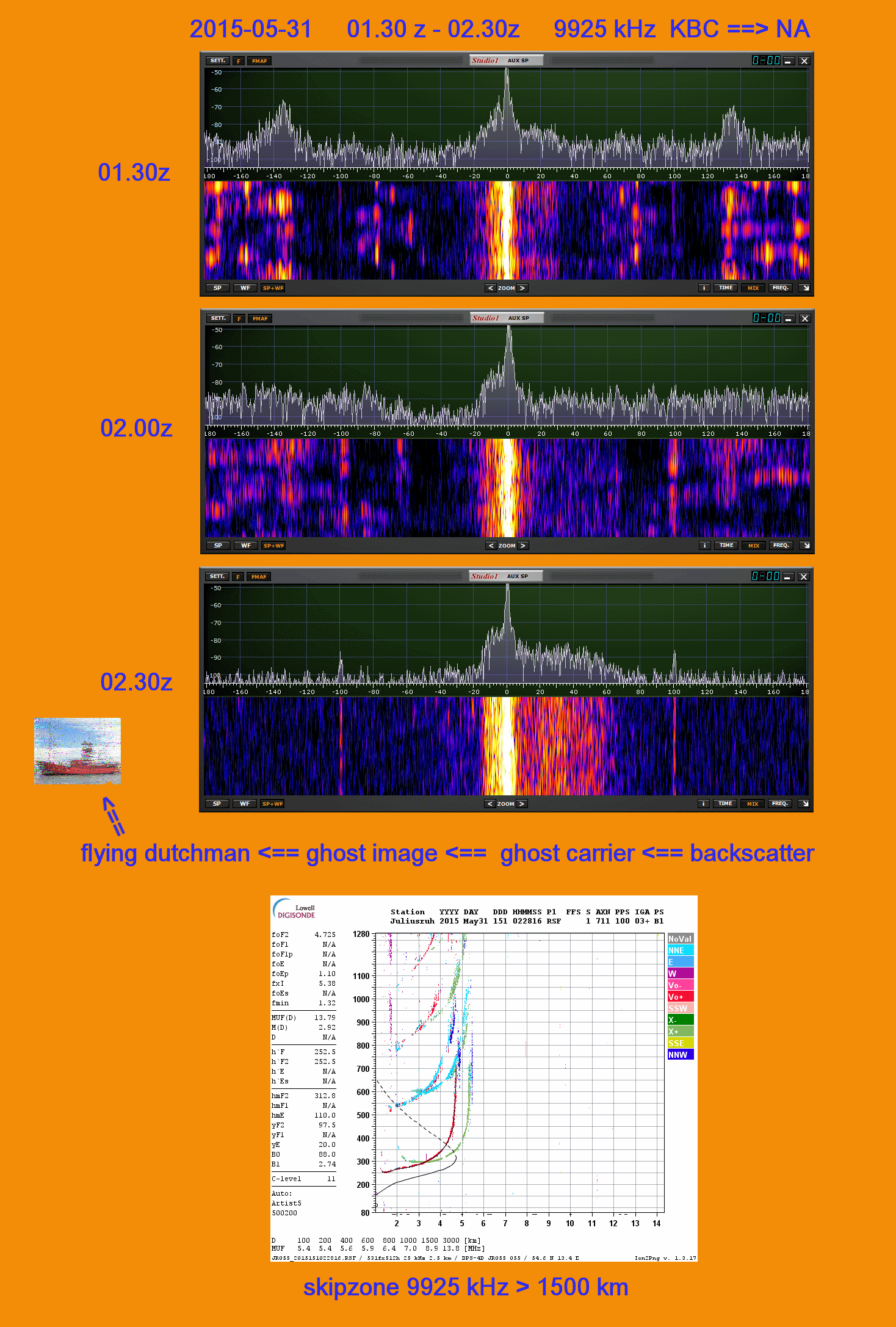
www.rhci-online.net/radiogram/radiogram.htm
██╗ ██╗██████╗ ██████╗ ██████╗ █████╗ ██████╗ ██╗ ██████╗ ██████╗ ██████╗ █████╗ ███╗ ███╗ ██║ ██╔╝██╔══██╗██╔════╝ ██╔══██╗██╔══██╗██╔══██╗██║██╔═══██╗██╔════╝ ██╔══██╗██╔══██╗████╗ ████║ █████╔╝ ██████╔╝██║ ██████╔╝███████║██║ ██║██║██║ ██║██║ ███╗██████╔╝███████║██╔████╔██║ ██╔═██╗ ██╔══██╗██║ ██╔══██╗██╔══██║██║ ██║██║██║ ██║██║ ██║██╔══██╗██╔══██║██║╚██╔╝██║ ██║ ██╗██████╔╝╚██████╗ ██║ ██║██║ ██║██████╔╝██║╚██████╔╝╚██████╔╝██║ ██║██║ ██║██║ ╚═╝ ██║ ╚═╝ ╚═╝╚═════╝ ╚═════╝ ╚═╝ ╚═╝╚═╝ ╚═╝╚═════╝ ╚═╝ ╚═════╝ ╚═════╝ ╚═╝ ╚═╝╚═╝ ╚═╝╚═╝ ╚═╝
|

RSID: <<2015-05-31T02:30Z
MFSK-64 @
9925000+1500>>
On June 1, The Mighty KBC begins broadcasting on 1602 kHz medium
wave, from the LV Jenni Baynton, in (or near) Harlingen Harbour,
the Netherlands. ...
|
Sending Pic:142x109C; |
via Twente: |
STUDIO - recording: |
Internet: |
|
If you can't hear 1602 kHz, try the audio stream ...
|
|
|
|
|
|
|
|
|
|
http://stream02.audisi.nl/kbc-high
http://5.189.129.36:8000/kbc-high http://5.189.129.36:8000/kbc-low http://5.189.129.36:8000/kbc-transmit http://5.189.129.36:8000/trtransmit
|
|
||
|
|
|
|
|
██╗ ██╗ ██████╗ █████╗ ██████╗ █████╗ ██████╗ ██╗ ██████╗ ██████╗ ██████╗ █████╗ ███╗ ███╗ ██║ ██║██╔═══██╗██╔══██╗ ██╔══██╗██╔══██╗██╔══██╗██║██╔═══██╗██╔════╝ ██╔══██╗██╔══██╗████╗ ████║ ██║ ██║██║ ██║███████║ ██████╔╝███████║██║ ██║██║██║ ██║██║ ███╗██████╔╝███████║██╔████╔██║ ╚██╗ ██╔╝██║ ██║██╔══██║ ██╔══██╗██╔══██║██║ ██║██║██║ ██║██║ ██║██╔══██╗██╔══██║██║╚██╔╝██║ ╚████╔╝ ╚██████╔╝██║ ██║ ██║ ██║██║ ██║██████╔╝██║╚██████╔╝╚██████╔╝██║ ██║██║ ██║██║ ╚═╝ ██║ ╚═══╝ ╚═════╝ ╚═╝ ╚═╝ ╚═╝ ╚═╝╚═╝ ╚═╝╚═════╝ ╚═╝ ╚═════╝ ╚═════╝ ╚═╝ ╚═╝╚═╝ ╚═╝╚═╝ ╚═╝
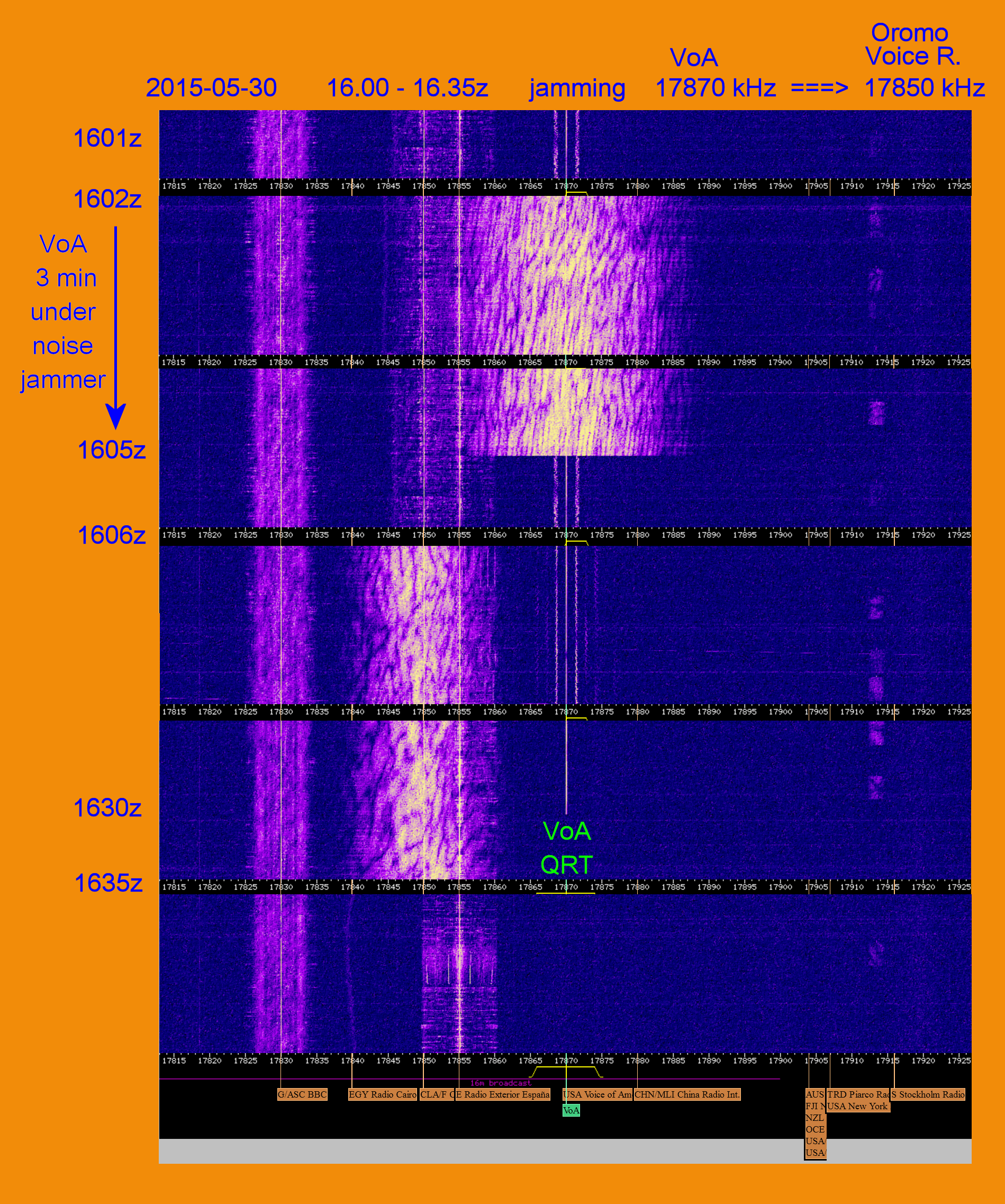
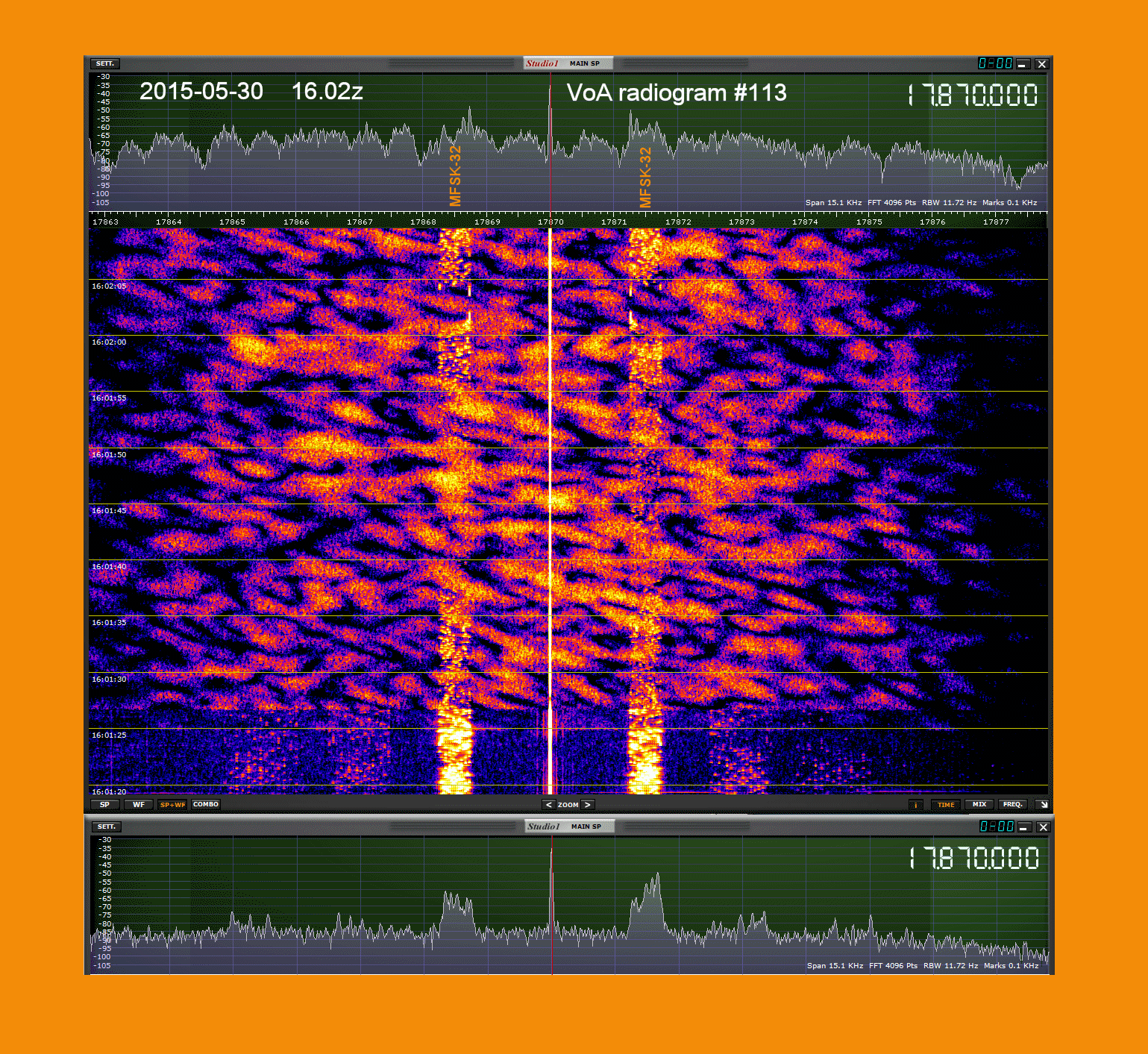
RSID: <<2015-05-30T16:01Z MFSK-32 @ 17870000+1500>>
Welcome to program 113 of VOA Radiogram from the Voice of
America.
I'm Kim Andrew Elliott in Washington.
Here is the lineup for today's program, all in MFSK32 except
where noted:
1:33 Program preview (now)
2:50 Science of nighttime thunderstorms*
8:21 Plankton are a major source of oxygen*
15:06 Volcano on Galapagos
18:08 SSTV PD180 test
21:28 Same image (but smaller) in MFSK32
25:11 Closing announcements
26:12 Bonus mode: Olivia 64-2000 at -16dB
27 17 Olivia 64-2000 at full audio level
* with image
Please send reception reports to radiogram@voanews.com.
And visit voaradiogram.net.
Twitter: @VOARadiogram
VOA NEWS
NOAA Scientists Hope to Unlock Secrets of Nighttime Thunderstorms
Rick Pantaleo
VOA Scince World Blog
20 May 2015
Most thunderstorms get their incredible energy from the sun's
heat, but some of the storms gain their strength at night,
baffling scientists.
To learn how these storms intensify, the US National Oceanic and
Atmospheric Administration – NOAA plans to keep 20 of its
scientists up late at night for a large intensive field operation
in the US western Great Plains called the Plains Elevated
Convection at Night, or PECAN, over the summer months.
According to NOAA, soon after sunset Earth and its lower
atmosphere tends to lose heat and becomes more stable. These
conditions create a less than an ideal environment for supporting
thunderstorms.
However, many summer thunderstorms, in the US Great Plains, take
shape soon after the sun goes down and sometimes does so without
an obvious trigger.
Conrad Ziegler, PECAN's principal scientist and a research
meteorologist for NOAA's National Severe Storms Laboratory said
that while large nighttime thunderstorms provide an important
source of rain for crops, they can also produce widespread and
potentially dangerous severe weather, excessive rainfall, flash
flooding and unusually frequent cloud-to-ground lightning.
"Weather forecast models often struggle to accurately account for
these," said Ziegler in a NOAA press release. "The PECAN field
campaign will provide us with valuable insights-and improve our
ability to save lives and property through more accurate
forecasts."
NOAA says that its scientists along with other investigators,
students and support staff from eight research laboratories and
14 universities will gather data with appropriately equipped
aircraft, a variety of ground-based instruments, mobile radars
and weather balloons before and during nighttime thunderstorms.
The PECAN researchers will conduct their field investigation from
June 1, 2015 to July 15, 2015 so that they will be able to better
understand just what triggers thunderstorms, what role our
atmosphere plays in supporting the storm's lifecycle as well as
the impact they have on the lives, property, agriculture and
water budget in the US western Great Plains region.
NOAA meteorologists believe that the specially targeted PECAN
observations will eventually lead to improved forecasts of these
potentially damaging storms.
http://blogs.voanews.com/science-world/2015/05/20/noaa-scientists-hope-to-unlock-secrets-of-nighttime-thunderstorms/
Sending Pic:200x144C;
|
|
denoised |
|
|
|
This is VOA Radiogram from the Voice of America.
Please send reception reports to radiogram@voanews.com.
VOA NEWS
Study: Plankton Are a Major Oxygen Source on Earth
George Putic, KI4FNF
May 26, 2015
Tiny ocean creatures collectively called plankton are mostly
thought of as food for whales and other large marine animals. But
a four-year global study has discovered, among other things, that
plankton are a major source of oxygen on our planet.
Plankton are animals, algae, bacteria and other microscopic
organisms invisible to the naked eye. They inhabit the upper
layers of the world's oceans, seas and freshwater.
In a project called Tara Oceans, led by the French nonprofit
organization Tara Expeditions, 200 scientists from 45 countries
took turns researching plankton aboard a two-mast schooner.
Setting sail in September 2009, the ship, Tara, visited 210
sites, where scientists collected 35,000 samples, researching the
lives, genetic makeup and movement of the tiny creatures.
Chris Bowler, Tara Oceans' scientific coordinator, said the
researchers discovered that plankton are responsible for much of
the well-being of our planet. The creatures are "generating the
oxygen we breathe, removing carbon dioxide from the atmosphere
and generally maintaining this Earth in a state that is habitable
for us human beings," he said.
Bowler said that close to half of the oxygen that we breathe
comes from diatoms — tiny, photosynthesizing algae that inhabit
the sunlit layer of all water bodies. "That basically means every
fifth time that you breathe, you're breathing oxygen which we can
directly trace back to diatoms," he said. "So they're sort of as
important as a tropical rain forest in terms of their global
contribution."
Expedition executive director Romain Troublé said the study
clearly showed that the ocean is the Earth's climate machine.
"We believe that the ocean is also the main driver of the climate
change, the main mitigator in the way that the ocean and the life
in the ocean is storing carbon dioxide, storing heat," he said.
"And this machinery works because the ocean is in good health."
Different groups of scientists studied different things. For
instance, one group cataloged over 40 million previously unknown
plankton genes. Another found that most of the plankton
interactions were parasitic.
The collected data will be used to determine which of the
organisms are most adaptable to changing water conditions.
Results of the first studies were published in the May edition of
the online scientific journal Science, which said that many
analyses would follow.
http://www.voanews.com/content/plankton-major-oxygen-source-earth/2791960.html
Image: Screen capture from the video version of this VOA News
story ...
Sending Pic:250x180C;
|
|
denoised |
|
|
|
This is VOA Radiogram from the Voice of America.
Please send reception reports to radiogram@voanews.com.
Galapagos Volcano Eruption Threatens Pink Iguanas
VOA News
May 26, 2015
Officials at Ecuador's Galapagos Islands National Park say a
volcano atop one of the islands has erupted, potentially
threatening a unique species of iguanas.
The nearly 1.8 kilometer-high Wolf volcano is located on Isabela
Island, home to a rich variety of plants and animals typical of
the archipelago that helped inspire Charles Darwin's theory of
evolution.
A statement posted on Twitter by the national park said that
while no human populations are threatened by the eruption, the
island is home to the only population of pink iguanas in the
world.
Ecuador's government was not immediately available for comment on
potential harm to the island's ecosystem.
Park officials say the Wolf volcano had been inactive for 33
years.
In April, unusual activity also was reported at the Sierra
volcano on the same Isabela island, the archipelago's biggest,
where yellow iguanas and giant turtles also live.
The eruption in Ecuador comes on the heels of eruptions in Chile,
another South American country located on the so-called Pacific
Rim of Fire.
http://www.voanews.com/content/galapagos-islands-volcano-eruption-threatens-pink-iguanas/2791014.html
Emiliano in Italy has been receiving slow scan television (SSTV)
transmissions from the International Space Station (ISS). The ISS
has been using the PD180 mode of SSTV. Emiliano suggests a
comparison of PD180 with our usual MFSK32 images.
So, let's try it.
The following image is in the PD180 SSTV mode. Its caption: The
Wolf volcano spews smoke and lava on Isabela Island in Galapagos
National Park, May 25, 2015.
MFSK32 will resume after the PD180 SSTV transmission.
|
17870 kHz |
5745 kHz |
|
|
|
|
|
|
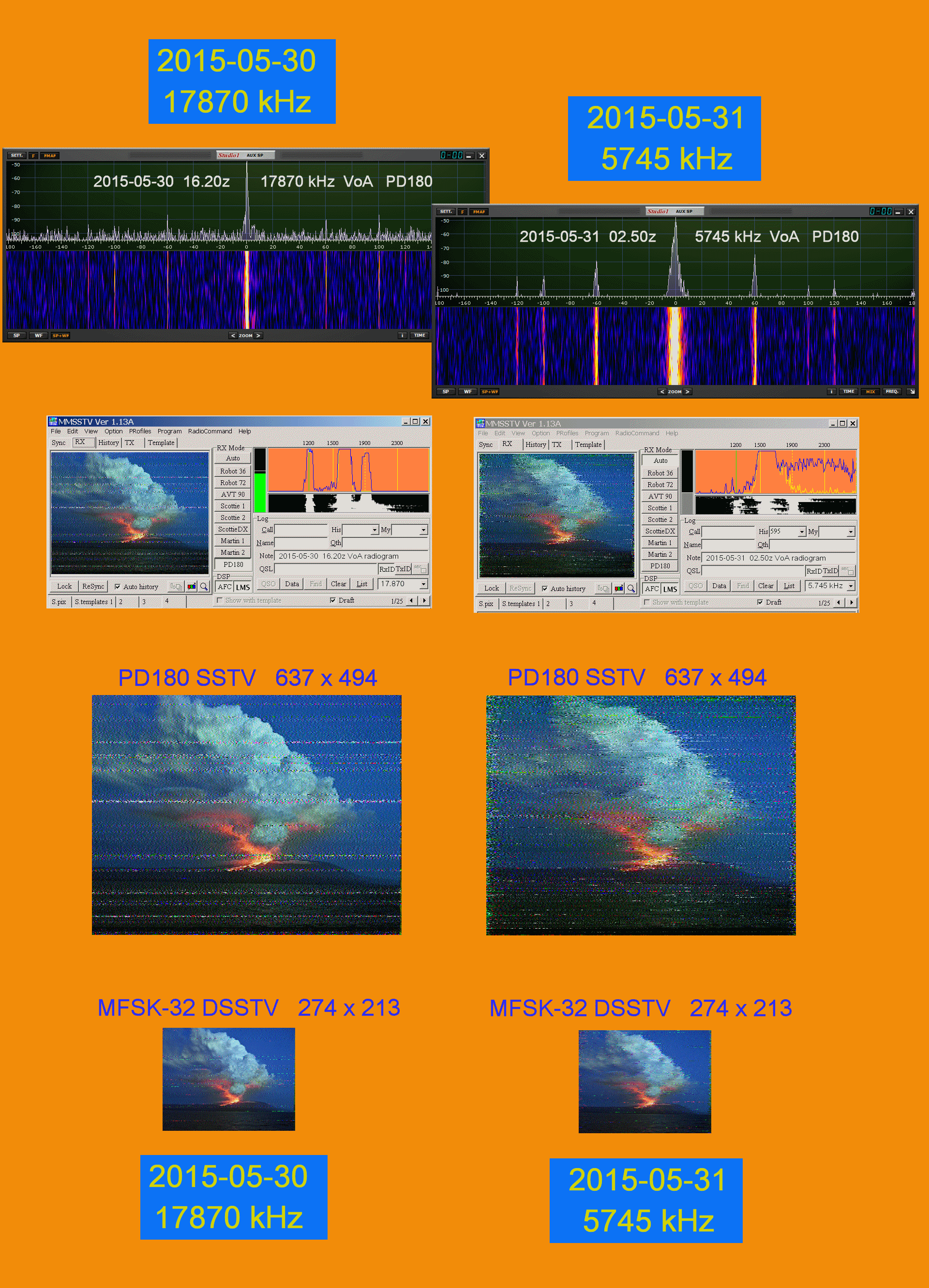
This is VOA Radiogram in MFSK32.
Please send reception reports to radiogram@voanews.com.
That PD180 SSTV image was 637 x 494 pixels. If I were to transmit
an image of the same size in MFSK32, it would take about 16
minutes! In the same 187 seconds required to transmit that PD180
image, here is the same image in MFSK32, 274 x 213 pixels ...
Sending Pic:274x213C;
|
|
17870 kHz / denoised |
5745 kHz / 2015-05-31 |
|
|
|
|
Please send reception reports to radiogram@voanews.com.
And visit voaradiogram.net.
Twitter: @VOARadiogram
Thanks to colleagues at the Edward R. Murrow shortwave
transmitting station in North Carolina.
I'm Kim Elliott. Please join us for the next VOA Radiogram.
This is VOA, the Voice of America.
RSID: <<2015-05-30T16:26Z
OL 64-2K @ 17870000+1500>>OLIVIA
- 16 db under
audio
VOA Radiogram Transmission Schedule
Days/times UTC
Sat 0930-1000 5745 kHz
Sat 1600-1630 17870 kHz
Sun 0230-0300 5745 kHz
Sun 1930-2000 15670 kHz
<<2015-05-30T16:27Z OL 64-2K @ 17870000+1500>>OLIVIA at full audio level
Thank you for decoding the modes on VOA Radiogram.
<<2015-05-30T16:29Z
CW @ 17870000+1500>>
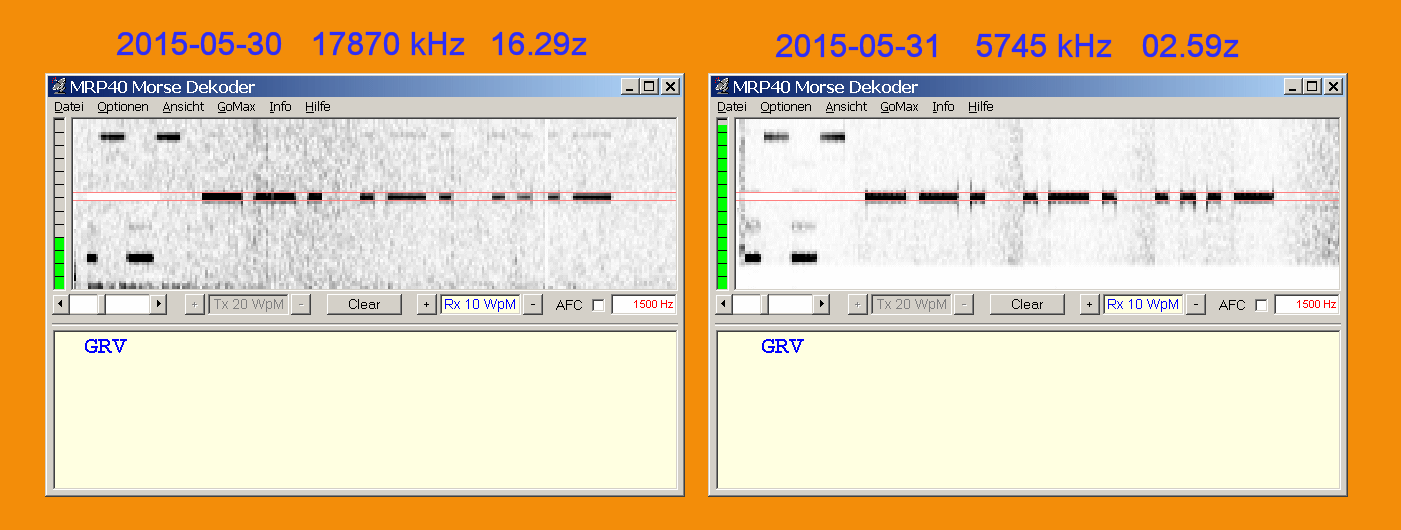
www.rhci-online.net/radiogram/radiogram.htm
|
QTH: |
D-06193 Petersberg (Germany/Germania) |
|
|
Ant.: |
Dipol for 40m-Band & Boomerang Antenna 11m-Band |
|
|
RX for RF: |
FRG-100B + IF-mixer & ICOM IC-R75 + IF-mixer |
|
|
Software IF: |
con STUDIO1 - Software italiano per SDR [S-AM-USB/LSB] |
|
|
Software AF: |
||
|
OS: |
German XP-SP3 with support for asian languages |
German W7 32bit + 64bit |
|
PC: |
MEDION Titanium 8008 (since 2003) [ P4 - 2,6 GHz] |
MSI-CR70-2MP345W7 (since2014) [i5 -P3560 ( 2 x 2,6GHz) ] |
DRM-images - received via EASYPAL/DSSTV on 14233kHz/USB (FRG-100 / Dipol for ~12 MHz)
Here are some pics of OH2BT [Risto Tiilikainen, Yhteistuvantie 14, FIN-02730 ESPOO, FINLAND ] received in the last time:
|
|
|
|
|
|
|
|
|
|
|
|
|
|
|
|
|
|
|
|
|
|
|
|
|
|
|
|
|
|
|
|
|
|
|
|
|
|
|
|
|
|
|
|
|
|
|
|
|
|
|
|
|
|
|
|
|
|
|
|
|
|
|
|
|
|
|
|
|
|
|
|
|
|
|
|
|
|
|
|
|
|
|
|
|
|
|
|
|
|
|
|
|
|
|
|
|
|
|
|
|
|
|
|
|
|
|
|
|
|
|